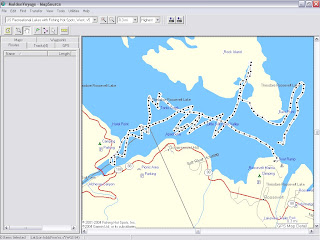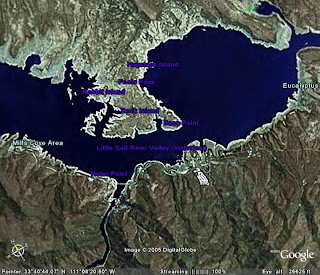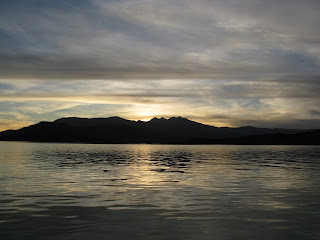
For a while now I’ve played around with the idea of going for a night sail. The idea came up while perusing various sailing websites and magazines, in which the writers would wax poetic about how magical and wonderful and sublime night sailing was, followed by advice to ensure you have 3 backups for your GPS, a 200-gazillion candlepower spotlight, horns, flares, generators, a liferaft ready to instantly deploy when the supertanker runs you over, and 3 harness tethers to firmly anchor you should you decide to foolishly risk life & limb by taking a whiz over the side of the boat.
I have fond memories of time spent at sea on various warships including destroyers, frigates, minesweepers, and amphibious craft of various types. I enjoyed simply being on the water, but especially enjoyed night watches when it was me, the dark sea, and a bazillion stars. When my watch was the after lookout, especially, it brought a sense of splendid isolation, and the boiling wake was almost hypnotic.
I vividly recall the first night I ever spent at sea—Aboard the USS Carpenter (DD-825) back in the early 70’s. I had been below in the CIC since shortly after the ship left the pier; CIC is a place that is kept dimly lighted because of the various radar consoles, light boards and plotters, so I never really had any sense of transition—It was daylight when I went in, and nighttime when I finally emerged. The passageways had switched to red night lighting, so my night vision was intact when I opened a door and stepped out on deck. The sight that I beheld took my breath away—A canopy of brilliant stars, more than I had ever seen in my life. It was almost enough to read by.
Entranced, I stood out there until the cold forced me back inside (then I spent the next few hours exploring the subtleties of projectile vomiting, but that’s another post).
When we were in waters where bioluminescent critters lived in the water, the phosphorescent wake and bow wave provided endless fascination. One thing that surprised me was in the ship's head—The urinals were fed by a constant flow of seawater. In the dim red night light, the urinals were glowing from the bioluminescent sea creatures. It was a wonderful, unexpected, and amusing thing to see.
A plan is hatched
So, reading about night sailing got my juices flowing. I am comfortable enough now with the Potter & sailing in general that I feel I can handle anything that comes up, short of plowing into a submerged nuclear submarine, an eventuality that I considered fairly remote on Roosevelt Lake. My biggest fears were idiot speedboaters, and finding a place to spend the night once I finally got tired of bumbling about in the dark.
The idiot speedboaters would probably not be a problem at the end of February; the beer-and-bimbos crowd tends to stay away until the weather warms up to bikini temperature—None of this tacking-back-and-forth-at-1-knot-wearing-woolen-undies stuff for them, nossir. The bass boats were a concern, because those guys were frequently out late in the bushes and weeds at the nether regions of the lake, and in a big, 60-knot hurry to get back to the ramp once they decided to call it a day. I figured that they would be most active right around sunset, so as long as I could avoid them then, I’d probably be home free.
Finding a place to spend the night was an interesting challenge. Most of my experience at Roosevelt has been in the middle portion of the lake, with the marina as a base of operations. In the overnight trips I had taken before, I was limited in range by time constraints, wanting to be safely moored or anchored or tied to a bush by nightfall, so I ended up spending the night in a narrow set of places that were close and familiar. I want to explore more of the lake, especially the southeast parts past Windy Hill; if I did not have to come in when it got dark, I could potentially venture a bit further out from my familiar haunts.
So I decided that I would sail around in the southeast portions of the lake. In daylight I would navigate southeast through the Windy Hill passage and then potter about exploring Terra Incognita (and identifying potential anchorages) until it got dark. Then I would navigate to the middle of the lake and basically sail about in circles until I was no longer amused, or Cocktail Hour beckoned, whichever came first . A regular James Cook, that’s me.
The big problem with this grand plan is I know nothing about the potential anchorages or moorings in the chosen nocturnal cruising area. I would be sailing or motoring into a confined cove, probably, in the dark, without any knowledge of submerged hazards, conditions of the bottom, and the like. My flashlights are puny. GPS is worthless in such scenarios. The chart lacks detail. How do I identify a safe and appropriate place to spend the night?
This is where the sailing magazine articles lose me, by the way. In those articles the biggest hazard was snaring a lobster pot as they motored into Manawassahassachusset with the autopilot steering towards a GPS waypoint glowing brightly on the 16-inch plotter. A flawless anchoring would be followed by a night spent eating crab, knocking back martinis while congratulating themselves on how yachty they are, and sleeping it off in the air-conditioned cabin after watching the latest movie on the flat-screen TV. If the generator goes on the fritz they are paralyzed until a mechanic can be flown in, and run a serious risk of warm beer for lunch.
My version of that would be stuffing the boat into a bug-infested backwater, surrounded by cacti, rattlesnakes, and javalinas, eating Ramen noodles, drinking 2-buck Chuck, and trying not to freeze my nautical arse off (winter) or melt into a pile of sweaty goo (summer). If the batteries last long enough I can read a sailing magazine or two before bedtime.
But I digress. I figure I can safely get into a given cove, even in the dark, if I go slowly and cautiously. But once in there, how do I know that my chosen spot is suitable for an overnight visit? What if there is a reef (okay, a rock) just inside my swing radius? What happens if the wind comes up? I know voyagers have been dealing with these kinds of issues since the first caveman inflated a Platypus carcass and sailed over the horizon to his doom, but given a choice I prefer a safer bet.
I fired up Google Earth and scrutinized the lake from outer space. A number of coves had potential for overnighting, and I marked them for uploading to my handheld GPS. I decided that precious daytime would be spent exploring the potential anchorages—That way I could probably assess several anchorages in the daylight and return with confidence in the dark, or rule out inappropriate locations without having to, say, smash up against a partially-submerged boulder. If all else failed, I could head to the Grapevine boat ramp, where a tiny pier was visible from the satellite, and overnight in relative safety listening to the RV folk frying fish and arguing about sports teams.
On the boat
I took my time getting up to the lake. Around 1400
Felicidade was ready for action, and we called the marina office for a launch. In short order we were being pushed into the water at the Sheriffs ramp. I was hoping I could do an engine-free launch, but the wind was coming from the exact wrong direction. I could have tied up to the dock and warped the boat around, but I didn’t want to invite the scrutiny of the local Federales by tying up their boat ramp for 90 minutes while I screwed around with dock lines trying to spin the boat around. So I sucked it in and fired up the motor. But I shut it down as soon as I got clear of the dock(about 30 seconds later) , and raised the main. Sailing!
The winds were very light, enough to get the boat up to about 1 knot in the puffs. Another sailboat, piloted by an engine-phobic numbnuts like me, was also trying to sail out of the harbor. We jigged and jagged as he gained on me slowly. I was pinching trying to get past the breakwater, but moving so slow that the boat was making too much leeway. I fell off just before the breakwater and jibed around to try a different tack. My course, on a starboard tack, took me across the bow of the other boat, but he was kind and cheerfully allowed me the right of way. We chatted as we passed, and then he made progress past the breakwater while I tacked towards the shoreline.
I tacked again, and this time
Felicidade cleared the breakwater after I broke out the paddle and helped the wind out a little. I followed the other sailboat out into the lake. Another sailboat was out there too, and for a while all 3 of us sailed in a loose formation past Rock Island. This was a rare occurrence on Roosevelt, 3 sailboats on the lake at the same time, sailing together in peaceful harmony. I reveled in the moment for a while. Then a bass boat blasted by at about 600 knots and left all 3 of us rocking in its wake, rigs slapping and banging.
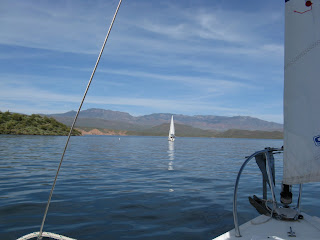
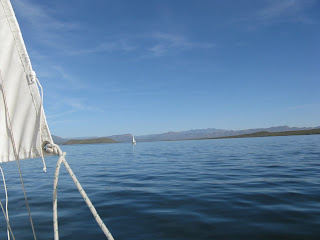
The other sailboats were bigger than the Potter, and slowly edged away from me in the light and flaky breeze. Looking across the lake I saw Windy Hill was not living up to its name on this day. Mirror water all around. My friend from the breakwater caught a breeze and headed off to Haystack Island while I ghosted along, listening to podcasts and eating lunch. After a while I caught the same breeze and headed towards the cliffs across the lake. It was becoming clear to me that unless I fired up the motor, I was not going to be exploring the southeast part of the lake this day. At that point Plan B was activated; I would get my night sailing jollies in my current location on he lake, then head to a well-known cove I had visited before to spend the night.
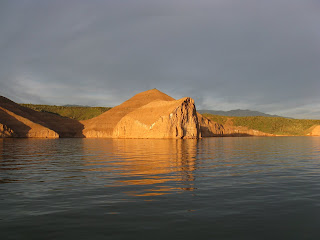
A new perspective
While I sailed slowly around waiting for sunset, I noticed that the land that normally connected Rock Island with the “mainland” was no longer visible—Indeed, bass boats were zooming up and down the lake using “Fools Pass”, as the chart proclaimed the new area of water. Roosevelt lake is at the highest level ever right now (indeed they opened the floodgates a couple of days prior to my visit because snowmelt was filling the lake to the brim), and there was now a shortcut to the cove where we would spend the night. Sweet! I filed that away and drifted about as the sun set.
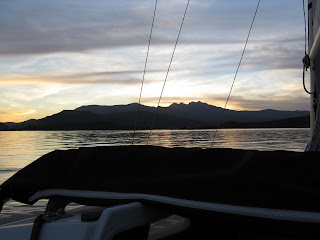
As the sun disappeared over the mountains, the wind followed it. I found myself bobbing on a windless, mirror lake. I took pictures of the floating wood and crud that was all around on the lake surface; this debris was washed down from the mountains when it rained. After the fires we had a few years ago, there was a lot of charred wood floating in the lake after the storms started up; this time it was small chunks of wood, pine needles, and the occasional log.
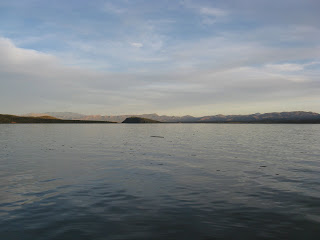
I took out the paddle and moved the boat along at .7 knots for about 5 minutes, which was only slightly amusing. By this point it became apparent that there was not going to be any night sailing unless the wind picked up, an event which never seems to happen when you want it to but instead happens at O Dark-thirty when you’re trying to sleep.

I made the command decision at that point to fire up the outboard and proceed apace to the camping spot while I still had some light. We motorsailed Northeast towards Fools Pass, where I pulled up short at a line of shallow-water buoys as the sky turned pretty colors. Hmm. It probably would not do to run aground in Fools Pass. I dropped the main, rolled up the Genoa, and raised the daggerboard, which consumed several of the remaining minutes of usable light.
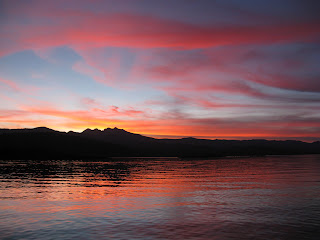
Disorientation
We motored past the buoys through Fools Pass as the light grew ever dimmer. I quickly found myself unsure of where exactly I was. I never approached from this direction before because this was always dry land; as I motored west, I could not identify any of the landmarks I was familiar with. I could detect an island directly ahead; I know there were some islands in that approximate location, but this was much bigger, so I guessed it was a high part of the now-submerged saddle that constituted Fools Pass. The GPS showed us making good speed over dry land, which was not particularly helpful, and the destination cove was not marked. I was winging it. This was an unanticipated challenge of navigating on a lake whose levels change constantly.
I turned southwest and proceeded slowly along the shoreline, trying to identify a familiar landmark. It was all dark & mysterious. After a few nervous minutes I saw a dim patch outlined in the darkness , and concluded that I was looking at the cliffs which signaled the entrance to the cove. I changed course to where I figured the cove entrance would be, and decided that if I could not definitely identify the cove very soon, I was going to abandon this Great-Navigator foolishness and head to the marina for the night.
As I motored slowly in, I recognized some familiar features and concluded with relief that I was in the right place. But it looked really, really different in the dark of night with the lake at unprecedented water levels; most of the familiar nooks & crannies of the cove were gone, and the peninsula that extended past the cliffs to protect the cove was completely submerged. I gave that area a wide berth as a we swung around into the cove, then I put the motor in neutral while I looked for a place to spend the night. I knew from soundings I had taken when the lake was much lower that the center of the cove was way too deep to anchor; I would not have sufficient swinging room for the 7:1 scope. So my plan was to nose into a friendly bush along the shoreline and tie up. I slowly made my way to the end of the cove, squinted into the darkness at some pale blobs dimly visible on the shoreline, and steered the boat towards them. I switched the motor into reverse to slow down, then neutral as we approached the shore. As the dim blobs grew before the bow I asked Old Neptunus Rex to help a poor shellback out and not let me be steering into a patch of Cholla cactus.
Felicidade landed softly, pushing her bow into a dried bush that promptly shattered into fragments as we slid to a stop. I shifted the motor into forward to hold us in place, then went forward and tied us up to a branch. Then I shut off the motor and evaluated the situation.
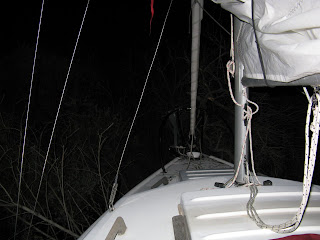
We appeared to be in a good spot. The boat was sheltered from the wind and sea (as memory served me from my daylight visits to the cove). She was tied to a fairly stout branch, as such things went. A submerged tree cast branches out of the water to sort of cradle the boat and keep her from being blown sideways. The hull was not touching anything hard. I was satisfied; after phoning The Wife and reassuring her that her idiot husband had once again cheated death, I declared the start of Cocktail Hour.
Dinner was cheese sandwiches and fruit. I fired up the iPod for background music while reading about how my more civilized fellow sailors were camping in Sail magazine. Life was good. I retired for the night.

And at O dark-thirty…
Right on schedule, I was awakened from a sound sleep by the most god-awful symphony of low-volume rattles, gurgles, booms, squeaks, bangs, moans, bumps and scrapes imaginable. The only thing missing was halyard slapping. The boat was shuddering to this racket in an odd sort of way. Slightly alarmed, I squirmed out of the V-berth and went topside to check it out. Sure enough, while I was asleep the wind had picked up-- Small waves were entering the cove from the lake, and being reflected into a chaotic pattern inside. This was not posing any hazard, but the wavelets were softly pummeling
Felicidade, causing all the racket and strange movement. At least were still well protected from the wind.
Reassured and slightly annoyed, I put in some earplugs and went back to bed while grousing about how the wind shows up when I’m sleeping, but abandons me when I am trying for an epic night sail. I managed to go back to sleep and had a good night’s rest despite the strange motion of the boat.
An engineless departure

After breakfast, I planned our escape. Now that I had light I could see outside of the cove; on the open lake it looked like decent wind was blowing. I saw a few small whitecaps as I looked out there and decided to put a reef in before we departed. There was an occasional gentle puff of wind where the boat was located, but no real wind until the center of the cove. I could see how the waves that had woken me up were getting into the cove—because the submerged peninsula was no longer fully protecting the cove entrance. I had not anticipated that.

I shot a video of the waves inside the cove, and got the boat ready to go. I decided to try an engineless departure, as the occasional puffs of wind were blowing off the shore and I could use those to get the boat out into the open. Just to be safe, I started the outboard, but left it idling in neutral—There was not a lot of maneuvering room and I did not want to run the risk of getting blown onto the lee shore if I could not get sailing quickly enough. But I needn’t have worried. I untied the boat and backed the main, and in a moment a gentle puff of wind pushed us off the shore. I steered us in the right direction, and Felicidade quickly caught the wind and began moving towards the mouth of the cove. I shut off the motor and partially unrolled the Genoa as we sailed out of the cove.

Voyage to Cholla Bay
A fine day of sailing ensued. The wind held steady at about 10 mph. I decided our destination should be Cholla Bay, about 5 miles to the west (and of course, directly upwind). Shortly after leaving the cove I shook the reef out and unrolled the Genoa, and before long we were making 4 – 5 knots upwind in a long series of tacks across the width of the lake.

Once we got to Cholla Bay, we turned downwind and sailed with the Genoa poled out at 2-3 knots all the way back to the marina. I discovered that I could leave the tiller tamer off, and steer the boat only by shifting my weight around- Cool! Lean right, boat turns left. Lean left, boat turns right. Now I understand why I accidentally jibed while I was forward on the starboard side attaching the fenders. Maybe I can set the rudder to counteract that next time. Or maybe I can lose some weight.
About 15 minutes out from the ramp I phoned the marina office for a haul out and rolled the Genoa up. Once inside the breakwater we sailed towards the sheriff’s dock at about 3 knots. I was slightly nervous, as this seemed kind of fast, but I managed to loop a cleat on the dock and snub us to a quick and gentle stop. In retrospect, I probably should have doused the main and brought her in using a partially unrolled Genoa. We’ll keep that in mind for next time.
A successful voyage, regardless
So, I didn't manage to accomplish a night sail. But I did have a fun trip regardless, despite the brief anxiety-producing transit of Fool's Pass. Next time I'll follow the sailing magazine's advice and bring a 150 bazillion candlepower searchlight to illuminate all of creation as I stumble around looking for a place to spend the night.
